#gusev crater
Text

"14 years ago today, on March 1, 2010, NASA Jet Propulsion Laboratory's #Marsrover #Spirit captured this view comprising its final pancam images showing one of its wheels stuck in soft sand around an area in #GusevCrater called Home Plate. Communication from Spirit ended 3 weeks later."
6 notes
·
View notes
Text

Unlocking an Impact Crater’s Clues
Mars is a dynamic planet. HiRISE has witnessed many surface changes over the past ten years, including hundreds of new craters formed by ongoing impacts. Most of these impacts are likely caused by asteroids that have strayed into collision courses with Mars. The planet’s much thinner atmosphere compared to Earth makes small asteroids less likely to burn up prior to hitting the Martian surface.
This new crater, which formed explosively at the point of impact, has a diameter of roughly 8 meters (about 25 feet), but its surrounding blast zone and ejecta extend over a kilometer (about one mile) beyond the crater itself. The materials exposed nearest the crater have distinctive yellowish and lighter grey appearances, while more distant ejected materials range from dark brown to bright bluish in an enhanced-color view. These varied materials may have originated from different layers penetrated by the impact.
This new impact was discovered using the lower-resolution Context Camera (CTX), also on board Mars Reconnaissance Orbiter. An older CTX image of this region from May 2012 shows a uniformly dust-covered surface, while a newer CTX image from September 2016 reveals the crater’s dark blast zone. New craters on Mars are easiest to locate in such dust-coated terrains, where they provide opportunistic “road cuts” that allow scientists to see beneath the dust blanket and determine the underlying rock compositions and textures.
This particular crater formed about 300 kilometers (roughly 200 miles) east of the Spirit rover’s final resting spot in Gusev Crater. (Enhanced color cutout is less than 1 km across.)
ID: ESP_048456_1640
date: 27 November 2016
altitude: 259 km
NASA/JPL-Caltech/University of Arizona
43 notes
·
View notes
Photo

Sunset Over Gusev Crater
Credits: Mars Exploration Rover Mission, Texas A&M, Cornell, JPL, NASA
40 notes
·
View notes
Note
Happy astromonday!!
If Venus is Earth's evil twin, Mars is Earth's... similar smaller cousin maybe? Anyway this new mini series is on Mars!! Here is sunset from his Gusev crater, look how small the sun looks compared to how we know it!!
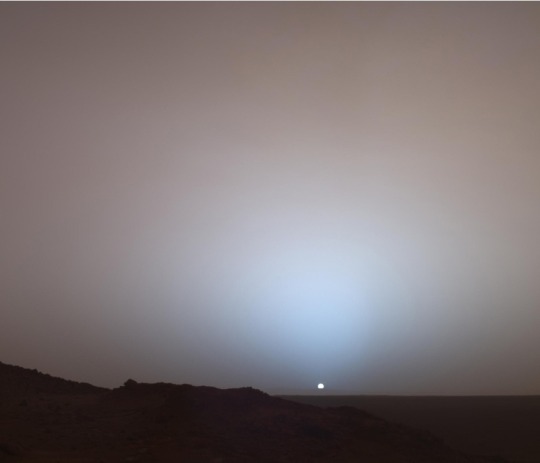
Mars is the fourth planet from the Sun at 142 million miles away (228 million km). He is the second-smallest planet (after Mercury), and takes 686 days to orbit the Sun - just under two Earth years. While Mars is much smaller than Earth - only about half the size - in some ways he is quite similar!! His day (known as sol) is 24.6 hours, only slightly longer than ours. And his temperature average is -63°C (-81°F) but in summertime is up to 18°C (70°F)!!
Known for his distinctive red colour in the sky, the ancient Egyptians named it "red one" and he is formally named after the Roman god of war. The red appearance is because of iron, making up the dust on his surface. This was heated and erupted from Mars' core by volcanic activity millions of years ago, which reacted to oxygen in the atmosphere, causing it to rust. Some of the dust is blown in dust storms in his atmosphere, so we see him as red from here.
He also has some of the most interesting geographical features in the solar system. He has polar ice caps like ours, with liquid water. Valles Marineris is a canyon up to 7km deep; originally thought to be a tectonic rift it is now thought to be a lava channel. Hellas Planitia is an impact crater deeper than the height of Everest (8.8km). And speaking of Everest, the extinct Olympus Mons at 25km high is the largest volcano in the solar system!!
I will go into more on human observations of Mars next week, for now have a fantastic day!! 🪐
Happy astromonday juno!!💖
That picture is wild IT LOOKS SO TINY OMG
Also I live for the fact that this mfker has the same temperature as literally any country in northern Europe dfhkhffgn we should consider moving there in summer (instead of lerwick, although that still sounds lovely around heat stroke season)
2 notes
·
View notes
Note
Happy astromonday!!
If Venus is Earth's evil twin, Mars is Earth's... similar smaller cousin maybe? Anyway this new mini series is on Mars!! Here is sunset from his Gusev crater, look how small the sun looks compared to how we know it!!
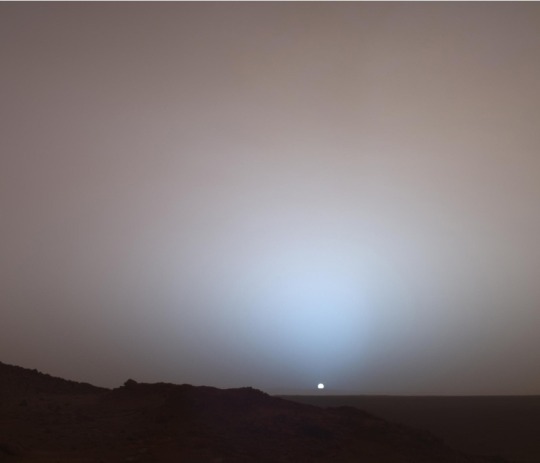
Mars is the fourth planet from the Sun at 142 million miles away (228 million km). He is the second-smallest planet (after Mercury), and takes 686 days to orbit the Sun - just under two Earth years. While Mars is much smaller than Earth - only about half the size - in some ways he is quite similar!! His day (known as sol) is 24.6 hours, only slightly longer than ours. And his temperature average is -63°C (-81°F) but in summertime is up to 18°C (70°F)!!
Known for his distinctive red colour in the sky, the ancient Egyptians named it "red one" and he is formally named after the Roman god of war. The red appearance is because of iron, making up the dust on his surface. This was heated and erupted from Mars' core by volcanic activity millions of years ago, which reacted to oxygen in the atmosphere, causing it to rust. Some of the dust is blown in dust storms in his atmosphere, so we see him as red from here.
He also has some of the most interesting geographical features in the solar system. He has polar ice caps like ours, with liquid water. Valles Marineris is a canyon up to 7km deep; originally thought to be a tectonic rift it is now thought to be a lava channel. Hellas Planitia is an impact crater deeper than the height of Everest (8.8km). And speaking of Everest, the extinct Olympus Mons at 25km high is the largest volcano in the solar system!!
I will go into more on human observations of Mars next week, for now have a fantastic day!! 🪐
Beautiful picture!! I am quite surprised to learn that there are ice caps on Mars, mainly because it’s so red! Though like you said, I guess he only appears red to us because of the dust.
Very excited for next week!
2 notes
·
View notes
Text
Meet the Contestants: Spirit

A selfie of Spirit [NASA/JPL-Caltech/Cornell]
Spirit was the first of the two twin Mars Exploration Rovers (MER), launched in June 2003 and landing in January of 2004 in Gusev Crater. Spirit had a planned mission of 90 sols, and ended up lasting 2210 sols (over 6 earth years) and driving nearly 8 km.
In that time it discovered high concentrations of salt in the Martian soli, possible meteorites, and weathered the Mars Year 28 (2007) global dust storm. In 2009, it became trapped in a location known as ‘Troy’, unable to drive out of the sand. Spirit became a stationary lander until 2010 when contact was lost.
Read more on the MER site.
Tune in for round 2 of the Mars Mission Tournament when Spirit goes up against 2001 Mars Odyssey.
1 note
·
View note
Text
Where Did the Spirit Rover Land on Mars?
The Spirit Rover is one of the two rovers launched in 2003 to explore Mars and search for signs of past life. The rover was sent to Mars to study the history of climate and water at sites where conditions may once have been favorable to life. It landed on Mars in January 2004 and began its mission to explore the planet’s surface.
The Spirit Rover landed in the Gusev Crater, a large impact crater…

View On WordPress
0 notes
Note
Happy astromonday!!
If Venus is Earth's evil twin, Mars is Earth's... similar smaller cousin maybe? Anyway this new mini series is on Mars!! Here is sunset from his Gusev crater, look how small the sun looks compared to how we know it!!
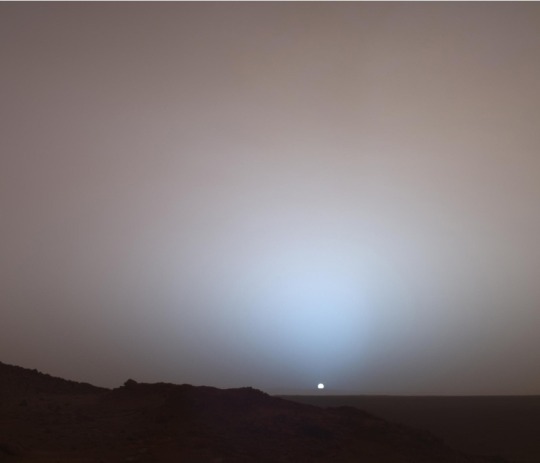
Mars is the fourth planet from the Sun at 142 million miles away (228 million km). He is the second-smallest planet (after Mercury), and takes 686 days to orbit the Sun - just under two Earth years. While Mars is much smaller than Earth - only about half the size - in some ways he is quite similar!! His day (known as sol) is 24.6 hours, only slightly longer than ours. And his temperature average is -63°C (-81°F) but in summertime is up to 18°C (70°F)!!
Known for his distinctive red colour in the sky, the ancient Egyptians named it "red one" and he is formally named after the Roman god of war. The red appearance is because of iron, making up the dust on his surface. This was heated and erupted from Mars' core by volcanic activity millions of years ago, which reacted to oxygen in the atmosphere, causing it to rust. Some of the dust is blown in dust storms in his atmosphere, so we see him as red from here.
He also has some of the most interesting geographical features in the solar system. He has polar ice caps like ours, with liquid water. Valles Marineris is a canyon up to 7km deep; originally thought to be a tectonic rift it is now thought to be a lava channel. Hellas Planitia is an impact crater deeper than the height of Everest (8.8km). And speaking of Everest, the extinct Olympus Mons at 25km high is the largest volcano in the solar system!!
I will go into more on human observations of Mars next week, for now have a fantastic day!! 🪐
Hello! I would have always thought Mars was the evil twin because it was all red and stuff, but it is what it is.
1 note
·
View note
Text
Ukraine figures at more than 440 children killed since the start of the Russian invasion
Ukraine figures at more than 440 children killed since the start of the Russian invasion
File – File image of a crater created by an explosion by Russian troops in kyiv, Ukraine. – Aleksandr Gusev/SOPA Images via / DPA – File
The Ukrainian authorities have estimated this Thursday at more than 440 the number of children killed since the start of the Russian invasion, unleashed on February 24 by order of Russian President Vladimir Putin.
The Ukrainian Prosecutor’s Office has indicated…
View On WordPress
0 notes
Photo
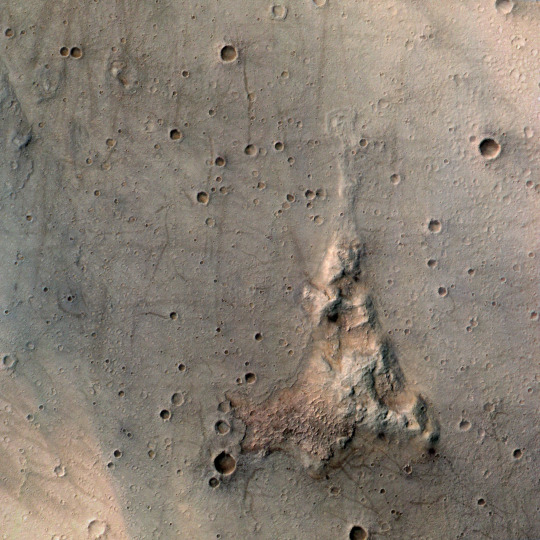
The Columbia Hills
This gorgeous processed image from the CTX camera on the Mars Reconnaissance Orbiter Spacecraft currently orbiting Mars shows the Columbia Hills, the final resting place of the Mars Rover Spirit. The overlain colors are from the CRISM instrument on the same spacecraft, and give an estimate of the composition of the rocks.
The rover landed on the nearly flat plains surrounding these hills to the West. It was targeted to a site known as Gusev crater, where a channel flows into the crater suggesting that it once might have hosted a lake. However, out on the plains, the rover discovered only basalt, remnant of more recent lava flows that once filled the crater.
In the distance, the rover could see a set of rocks sticking up above the lava-covered plains, named the Columbia Hills after the shuttle Columbia broke up upon reentry. Once the Rover arrived there, it began finding different rocks, including igneous rocks of different composition and eventually pyroclastic and hydrothermally altered rocks, verifying the presence of water as hot, water-rich fluids were required to produce the observed altered rock chemistry.
Eventually, the rover was trapped when a section of a set of altered rocks nicknamed “home plate” collapsed, leaving the rover buried in sediment just before the start of a martian winter.
It is unknown why the Columbia Hills stick up above the surroundings. They may have been a high ground that existed before the lava flows formed, or alternatively they could represent a portion of the earlier lake sediments that were uplifted on a fault of some sort, perhaps one related to settling of the crater itself. In this case, the observed altered rocks would have been sediments that interacted with high-temperature fluids and igneous rocks during later volcanism.
-JBB
Image credit: NASA / JPL / JHUAPL / MSSS / Justin Cowart
https://flic.kr/p/2jYE5Ca
#Spirit#mars#mer#mars exploration rover#gusev crater#basalt#geology#columbia hills#mro#mars reconnaissance orbiter#space#science#the universe#isuniverse#the real universe
39 notes
·
View notes
Photo

Sunset Over Gusev Crater
Credits: Mars Exploration Rover Mission, Texas A&M, Cornell, JPL, NASA
0 notes
Photo

Sunset at the Gusev Crater on Mars, captured by the Spirit rover in 2005 via /r/spaceporn https://ift.tt/2OHh0LN
1 note
·
View note
Text
How We Decided
The day after tomorrow- that is, February 18, 2021- the Perseverance rover will attempt to land on the surface of Mars. It will enter the planetary atmosphere at an acute angle, giving it as much time as possible to experience drag and slow down from orbital velocities. Because Mars’ air is so thin, and the rover is so heavy, this will fail- in the best case, Perseverance would still be going almost a thousand miles an hour when it impacts the surface. To help save itself, the craft will deploy a parachute of advanced design, seventy feet across and able to withstand supersonic velocities. This, too, will fail. Even with a parachute, there is simply not enough air between Perseverance and the Martian surface to slow it down all the way. So this is where the rockets kick in. Once air resistance slows the rover to a bit less than two hundred miles per hour, the heavy heat shield will be jettisoned, and a system of secondary rockets will fire against the direction of motion until it slows to near-hovering. In a final flourish, the rover will descend from the rocket-boosted frame on coiled springs, until it touches down in the western part of Jezero crater in the northern hemisphere of Mars.
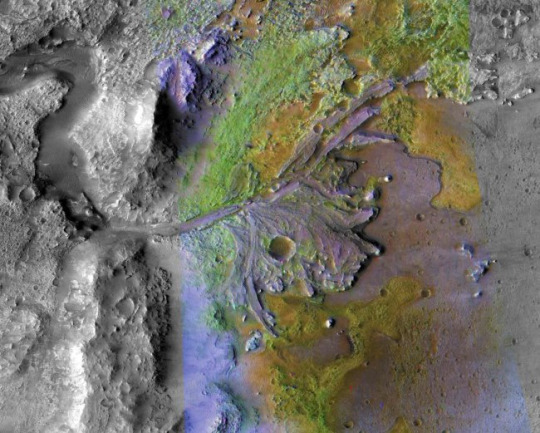
As it happens, Perseverance’s destination was one of the very last things we decided about it- not until the craft itself was fairly thoroughly engineered and designed. Formally, the decision was made by the mission directorate. In practice, they follow the consensus of the scientific community, which in turn hashes things out at a series of open-invitation workshops. Things began with a call for white papers- an open suggestion box, basically. In 2015, the first workshop narrowed things down from thirty serious proposals to eight candidates. In 2017, the second workshop further winnowed the list down to three. And in October of 2018, after three days of presentation, debate, and discussion, the final workshop selected Jezero Crater from these final three candidates using a simple vote of all attendees, and passed on the recommendation to the mission leads.
I haven’t been in the business for very long, so the final workshop was the only one of these where I actually participated. It wasn’t a close vote as such, and I didn’t break any ties, and technically we were just making a strongly worded suggestion. Nonetheless, my vote is one of the reasons why the Rover will be going to Jezero Crater instead of Syrtis Major or Gusev, and I think I’m entitled to feel ownership of this mission choice, just a little bit.
(This is, of course, terrifying.)
Having gone through the experience, there were a few surprises worth noting. The first was how small some of the numbers are here. The conference was not very large: only thirty proposals, debated by just a few hundred attendees. I’ve seen book review contests with more entries, and that are read by a wider audience. Which is to say, this is a situation that was, and is, extremely responsive to individual effort. In that small a room, populated by people that are philosophically committed to changing their minds when they see good evidence or a good argument, one person can stand up and change the future in a very real way.
The second surprise was the attendance requirements. Or rather, the lack thereof. The project is public, paid for by American taxpayers, to whom I am profoundly grateful. And one way the process reflected that public-spiritedness is that this is not a walled garden. A small attendance fee (iirc, $40?), and you’re in. You get a vote, if you want to use it. A few non-scientists even took us up on this; there’s one retiree (a former schoolteacher, I think) that’s attended every major conference I’ve been to in the last few years, and sets up a small table in the back with his home mineral collection just for fun. In practice this open-door policy is limited by the obscurity of the event itself; if you don’t move in research circles, you have to be something of a space exploration superfan to hear about it. Still, as symbols go, you could do worse.
And now that we’re coming up on the day itself, the same kind of public-facing mindset is making me think about why I was persuaded to vote for Jezero Crater, what it means to explore there, and how I’d justify that choice to those of you that made the ongoing discovery of Mars possible in the first place.
If you want to know what Perseverance is like, and what you can reasonably do with it, start with Curiosity- the two are built, more or less, on the same chassis. That means you have a mobile science lab about the size of a Volkswagon Beetle. Add some mechanical improvements (no more wheel punctures!) and a few bells and whistles (microphone! helicopter for some reason!). Trade out some of the scientific instruments- raman spectroscopy instead of a mass spectrometer, for example. And it’s got these:
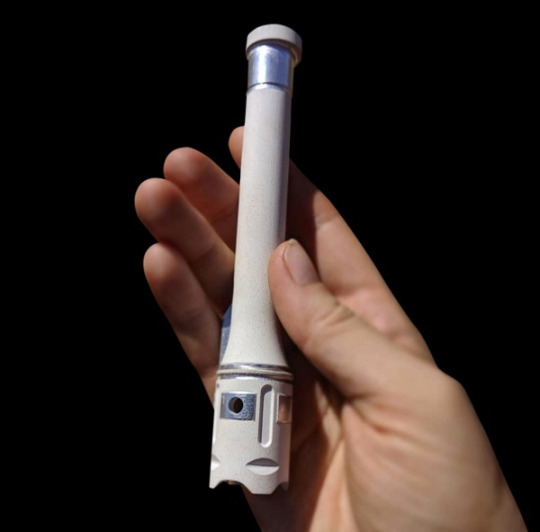
That, dear reader, is a sample return canister. Not to be returned immediately, alas, but to be returned nonetheless. One of Persevereance’s primary directives is to find interesting rocks, collect them, and leave them in place for a sample return mission in the early 30s. There’s a ton of work we can do in situ, but there’s even more we can do in a clean lab back home; things like isotopic analysis really need a much more controlled environment than you’ll get in the field. And so a major, major consideration is to optimize Perseverance’s landing site for cool rocks that we’d like to take back home.
The other thing that Perseverance is really good at is astrobiology. There’s no such thing as a life sign detector as such, but this rover represents an attempt to approach that ideal: instruments like SHERLOC and SuperCam are adept at finding organic compounds and fine-scale mineralogy and chemistry that might be influenced by microbial metabolism. This is a natural extension of what we’ve been learning so far: Spirit and Opportunity showed us that Mars formed under the influence of liquid water. Curiosity showed us that this was not just wet, but actively habitable: lakes and rivers at a neutral pH under a rich and temperate atmosphere. The next question along this line is the hardest, and the scariest: we know it was habitable, but was it inhabited?
If you’re like me, that question makes you feel weird. Collecting rocks is one thing, but a fossil? The mind rebels. We’ve spent the last two generations of space exploration tempering our expectations, reminding ourselves that the other worlds in our solar system are largely barren and dead, learning again and again how precious life is in the cosmos. It’s hard to get in the mindset of people back in the 40s and 50s who could, somewhat reasonably, imagine that Mars might not just host life but multicellular life, vegetation and robust macroscopic ecosystems. We look back at the science fiction of the era, swarthy soldiers hopping from planet to planet in silver rockets, and laugh at the naivete. A smile at the exuberance of youth, if we’re feeling generous. When we were first beginning, we may have imagined ancient canals on Mars and crystal cities on Venus, but that was when space was a blank canvas for us to paint our fantasies. We’ve learned so much since then, and if it was less fun, at least it was true. We did the hard thing and accepted reality over fantasy. We accept that extraterrestrial environments are hostile to life- cratered, silent, and still. We’re grownups now.
Unless…
Unless.
Imagine that we were born just a bit earlier. Say, three and a half billion years or so. We raise our telescopes to the sky, and we see a sister-planet. Not red, but white and blue, with an atmosphere full of clouds and multiple large bodies of water scattered across its surface, prominent ice caps and snow-capped highlands, rivers tracing their way down to the lowlands in the north. (Maybe the water is all under the ice, not open to the air at the surface; maybe the liquid pools are small and limited to craters, not feeding a large ocean.) Sober scientists might have suggested we shouldn’t get our hopes up too much- after all, the gravity is much lower, there’s no tectonic recycling, and there’s no protective magnetosphere. But is sterility really the default assumption we should be making here? Is ‘we are alone in the cosmos’ really the most sane conclusion to draw from this situation? Is it not worth, perhaps, sending a rover to go see?
We’ve adapted our sensibilities to a dead solar system because in the moment we’re looking, it kind of is. We’re hopeful for the icy moons- and the evidence keeps mounting there as well- but the terrestrial planets are a grim reminder of the fragility and contingency of our own world. The thing is, the more we learn, the more we discover that we’re a bit late to a very, very interesting party. Venus is a hellscape, but it probably didn’t start that way. Mars is a desert, but once it was an oasis. What makes Earth special among the terrestrial worlds isn’t that it developed a temperate climate, but that it kept a temperate climate for more than four billion years. Stability, not habitability, is the party trick that makes us unique in the solar system. And if we’re really committed to being grownups, to accepting what’s real instead of what’s easy, we have to learn that lesson too.
And life does not need four billion years to begin. Not even close.
That brings us to Jezero Crater. The most interesting feature here is a large river delta- based on some clever geology, we’re pretty sure that a large river emptied into the crater during Mars’ wet period. When the rapidly-flowing water hit the still water of Lake Jezero, the loose sediments being carried along the current all fell out of suspension at this place, forming a large pile of detritus at the mouth of the river that accumulated over the lifetime of the system. Even more interesting, check out this geologic map:

See those tiny teal deposits to the right side of the image? Those are also river delta deposits. Which means the thing labeled ‘delta’ on this map isn’t the original extent- it used to be much, much larger, at least twice as wide. Which also means that the outer edge of the ‘delta’ that we see here in this image is actually an erosional surface, and we get a natural cross-section of the thing with the oldest deposits at the bottom and the youngest at the top, just before Mars lost its hydrosphere. By climbing the outer edge, we can move through time across a large fraction of the habitable period.
Here’s another image I’d like you to see:

The crater I’ve been showing you is the small circle in the lower right- color is elevation, covering a span of about 5 km. The black line is the watershed of that river, the region of Mars that channeled water to the delta. In other words, the river delta collects sediments- and potentially, biosignatures- from a region hundreds of kilometers in diameter, and gathers them all in one place, neatly sorted by time.
For this reason, ancient deltas on Earth are a favorite of paleontologists. In addition to being comfortably wet and active itself- plenty of access to biologically important nutrients, fresh supplies of liquid water, and a nice dynamic environment- deltas do the legwork for us. Rather than exploring a huge fraction of the planet with a tiny rover, hoping that we stumble upon an ancient life sign, we can position ourselves at the mouth of the proverbial fire hose and let life come to us.
This does come with some tradeoffs. Most importantly, whatever we find, we won’t know the original geologic setting. If we find an unambiguous fossil of some kind- a microbial mat, perhaps- then we’ll know less than if we’d found it in its original home. And if we don’t find life, then the samples we take will be similarly uncertain. They’ll be defined in time, at least relative to one another, but not in space. In the case of life signs, this is an important caveat, but the bare fact of proving that extraterrestrial life exists is sufficiently monumental that it’s still a secondary concern. But if we’re just talking about geology, that’s a hard thing to lose; that terrifying multi-stage descent isn’t the only risk we’re taking. We’re leaning into the astrobiology mission hard with this one.
And the search for life is, in itself, fraught. That’s putting it mildly. There’s every chance that any evidence that’s even slightly marginal is going to touch off decades of debate, rather than being some kind of slam-dunk. As it should! Life is such a fuzzy concept, and such an important concept, that it should absolutely be held to the highest degree of scrutiny we can muster. This is why it matters that Perseverance includes sample return- in the highly likely case that the findings are disputed, we’ll hopefully have the chance to subject those samples to the highest degrees of scrutiny. So it feels like the right time to go hunting.
On top of that, there’s the ‘evidence of absence’ problem. Strong biosignatures update our priors very hard in the direction of life on Mars. But what is the correct amount of evidence necessary to convince us that Mars never was alive? I’m not sure, but failure to find microbial mats in Jezero probably isn’t enough. So the search for life can succeed, but if it ‘fails’ that doesn’t necessarily teach us much; the best experiments teach you something no matter what, and ideally a commitment this large would meet that standard. This is, more or less, baked into the search for extraterrestrial life, and there aren’t too many ways out from under that problem.
That said, Jezero in particular has some compensation. As I mentioned, we’re collecting a lot of good data regardless; and even without the gologic context, there’s a ton of opportunity to sample different minerals and how they formed, and get a nice broad sample of the Martian surface over time. And, even better, here’s the location of another interesting potential field site, in northeast Syrtis:
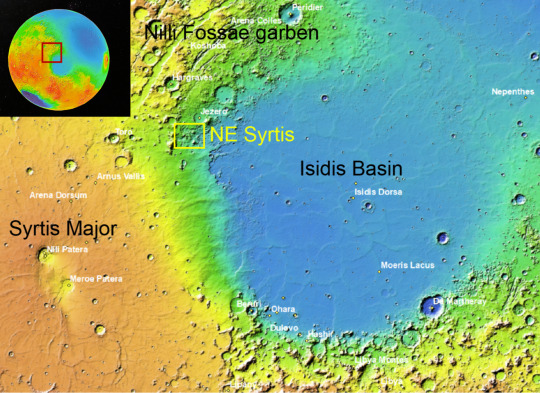
Note the proximity to Jezero crater! And Syrtis is also a fantastic candidate for a sample return mission. It has exposed mesas with layered outcrops going all the way back to the earliest days of Mars, and extending (potentially) through many of the most interesting periods. Now, these are not ideal for the search for life, although they’d give us a ton of technical data about surface chemistry and the behavior of the atmosphere during the early, wet periods; it would go a long way towards resolving arguments about the temperature of the early Martian climate, for example, or tracing the early destabilization and loss of the magnetosphere while teaching us loads about the planet’s core.
Those mesas are still pretty far away. Too far, probably, for a sensible rover lifespan to make it all the way there. But there’s a plan- called the ‘Midway’ route, as a nod to the compromise nature of it. See, halfway between Jezero and these mesas, there are a lot of banded rocks that look suspiciously like they’re sourced from the table mesas in Syrtis. And those, we can get to, maybe. If we call a specific deadline on looking for life in Jezero, then we can pivot to Midway and hopefully take a really deep look. So, in the end, we’re going hard for astrobiology research, but we’re not going all-in.
The importance of the search for life is… well, there are a lot of people out there, and we enter the world in a lot of different ways. Most of us agree that the existence of extraterrestrial life would be a Big Deal, and we tend to have a lot of different reasons for that. It’s not a bad subject for a future post or three, in fact. But there’s one thing lurking in the back of my head that’s a non-obvious reason to go looking. This wasn’t discussed at the workshop particularly, but it fed into my vote somewhat. Check the logic of this for me, see if it makes sense:
Worrying about existential risks, we sometimes talk about the ‘great filter’. That is, the mysterious phenomenon which explains the lack of extraterrestrial civilizations reaching out to us. Now, maybe we’re in a zoo or a preserve or something, and intelligences are out there watching after all; maybe the Earth really is the center of the cosmos, because of the simulation hypothesis or the various religious explanations. There’s no real way to know for sure at this point. But consider the space of very real possibilities where the universe actually is material, and actually is mostly barren. Why?
Stepping through the sequence, it might be that abiogenesis is really hard- going from a temperate world to a living one is almost (but not quite) impossible. Maybe there’s some hurdle to clear between genesis and encephalization. Maybe, given encephalization, civilization and tool-use are almost impossible. Or maybe there are many civilizations like ours, and the great filter is ahead of us- it is almost impossible for technological civilizations not to self-destruct or turn in to lotus-eaters before they reach interstellar civilization. There are a lot of possibilities for the filter, and for present purposes we’ll divide them into two categories: those which we would have already passed, and those which are in our future.
And here’s the thing: for each possibility we can exclude from the great filter, all the other possibilities increase commensurately, becoming more likely in our estimation. (Assuming the exclusion is ‘clean’ and doesn’t favor some other possibility, that is.) Given that the silence continues, if we could somehow prove that technological self-destruction isn’t a big risk, that would commensurately increase our guesses about how hard abiogenesis is.
Life on Mars, especially if we could be very sure that it evolved independently of Earth life, would be a strong argument against the difficulty of abiogenesis. One biosphere in the solar system, and nowhere else, might be down to luck. The one biosphere has to be somewhere, right? Two in the solar system, and nowhere else, is a good bit less reasonable. If we find a second genesis on Mars, then we’ve learned that life is not rare. That the hundreds of billions of stars in the Milky Way are likely host to many billions of different living (or at least once-living) worlds.
And as wonderful as that news is, as much as it makes me so happy that I literally had to take a second to cry on my bed for a bit, it also makes the great silence much, much scarier. Today, we can reassure ourselves by saying that life may be rare in the universe. But what if it isn’t? If the cosmos is full of life, but not full of thought, then…
If this is the case, we need to know. We need to know as soon as possible, and we need to know it while we’re engaged in the great project of technological development and moral progress. It’s easy to imagine that this particular mission is one that can be framed in purely positive terms- the joy of discovery, the vastness of truth, the love of how things might be. But I do also have this sense of civilizational fragility, you know? And understanding the risks that we face and the chances we’re taking- that’s not idle curiosity. That’s genuinely urgent.
212 notes
·
View notes
Photo






@demondeals asked: Doctor Who + favourite location
Bowie Base One, established in Gusev Crater, Mars. Founded in July 2058. This place is a distance, you could do with bikes in this place. All I’m saying is, bikes. Little foldaway bikes, don’t weigh a thing.
645 notes
·
View notes
